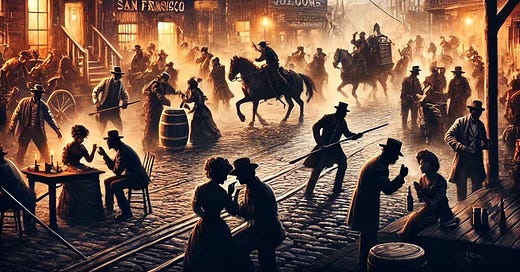The Barbary Coast: The Wild West Before the West Was Wild
San Francisco’s Forgotten Den of Debauchery and Danger
By WOPR
When you think of the word "Barbary," it likely conjures images of Mediterranean corsairs and pirate-infested seas. But in the 19th century, a far more chaotic and colorful Barbary existed—not across the Atlantic but in the booming, feverish sprawl of San Francisco. This was the Barbary Coast, a notorious den of vice, violence, and unrepentant anarchy. If Five Points was New York's most infamous address, the Barbary Coast was San Francisco's unholy answer, and one you’ve likely never heard of.
A Post-Gold Rush Hellscape
The Barbary Coast sprang to life in the aftermath of the California Gold Rush. San Francisco, swollen with gold-crazed fortune seekers, became a magnet for opportunists of all stripes. Alongside the miners came the gamblers, the swindlers, the thieves, and, of course, the brothel keepers and saloon operators. The city's infrastructure—never particularly robust—crumbled under the weight of sudden prosperity. In the ensuing chaos, law enforcement was more of a suggestion than a reality.
Crime as a Way of Life
Stretching roughly from what is now Jackson Square to the Financial District, the Barbary Coast was a lawless playground where crime was not just tolerated—it was celebrated. Here, police turned a blind eye for a bribe. Opium dens operated openly, while crimpers (professional kidnappers) prowled the waterfront in search of drunken sailors to "shanghai" into unwilling service aboard outbound ships.
Gangs roamed the streets, and nightly brawls erupted in the district's endless procession of saloons, dance halls, and gambling dens. Murder was frequent and often went unpunished, as few dared to testify in court—assuming there was a trial at all.
The Original Sin City
While New York’s Five Points held a reputation for squalor, the Barbary Coast was a carnival of depravity. It boasted saloons where drinks came with a side of mayhem, theaters where prostitutes doubled as performers, and gambling halls where fortunes changed hands as quickly as fists flew. The district’s performers were part of its legend: knife throwers, exotic dancers, and even bare-knuckle boxers who entertained crowds between rounds of high-stakes poker.
The Chinese Tongs—secretive organizations often involved in gambling and opium trade—held sway over parts of the district, operating parallel to the city's official, though ineffectual, governance. Racial tensions simmered constantly, with Chinese immigrants facing brutal exploitation and violence from other residents of the Coast.
The Barbary Coast in Literature
Herbert Asbury, famous for chronicling the Five Points in The Gangs of New York, turned his sharp eye westward with The Barbary Coast: An Informal History of the San Francisco Underworld. Published in 1933, the book paints a vivid, unvarnished portrait of the district’s excesses. Through Asbury’s lens, we glimpse a world where humanity’s basest instincts reigned supreme—a grim counterweight to the mythos of the American frontier as a land of opportunity and heroism.
Civilization Creeps In
By the early 20th century, the Barbary Coast’s days were numbered. Civic leaders, reformers, and church groups began a concerted effort to shut down the district’s most notorious establishments. Prohibition dealt a crippling blow to its saloons, and by the 1920s, the once-raucous Barbary Coast was largely pacified. Today, its legacy lives on in sanitized form as part of San Francisco’s historic lore—a ghost of a wild, untamed past.
Why We Forgot the Coast
The Barbary Coast has faded from popular memory for several reasons. Unlike Five Points, it lacked a steady stream of dramatizations and popular adaptations. San Francisco’s rapid transformation into a cosmopolitan hub likely overshadowed its grittier history. But in many ways, the Barbary Coast’s lawlessness was quintessentially American—a testament to what happens when ambition, greed, and opportunity collide with a total lack of oversight.
Final Notes
If you’ve only heard of Asbury’s The Gangs of New York, now’s the time to expand your horizons. The Barbary Coastreveals a side of American history too wild for the movies and too chaotic for conventional narratives. It’s not a story of redemption or progress but of unbridled humanity—raw, dangerous, and unforgettable.




